- Research Center for Societal Safety Sciences
- Informational Video on Disaster Prevention
- Academic Papers “Journal of Societal Safety Sciences(JSSS)”
- Publications of the Faculty of Societal Safety Sciences
- Disaster Survey Reports
- A survey report on the 2018 North Osaka Earthquake A survey report on the 2016 Kumamoto Earthquake A Survey Report on the 2011 Great East Japan Earthquake Outline of the Symposiums Concerning the Great East Japan Earthquake
Survey Report on The Administrative Organization's Support System in the Initial Response to The Kumamoto Earthquake (1st report)
As of May 1, 2016
Shozo Nagata, Associate Professor, Kansai University
Outline:
In the Kumamoto Earthquake, the foreshock occurred at 9:26 pm on April 14, 2016, and the main shock occurred at 1:25 am on April 16 with which the damage expanded, and the countermeasures remained unclear. Concerning the Kumamoto Earthquake, its similarities with the Niigata Chuetsu Earthquake (2004) are often pointed out with respect to the scale of the earthquake and its characteristics. However, from the perspective of disaster prevention research, it seems that the similarity with the eruption disaster of Mount Usu in Hokkaido (2000) is rather large. Common to the eruption disaster of Mount Usu in Hokkaido and the Kumamoto Earthquake is that they are the first large-scale natural disasters to have occurred after very large disasters occurred right before. As a test case of the new institution / system that the national government is building after the last disaster, these disasters that occurred afterwards have important meanings in disaster prevention research. Whenever extremely large-scale disasters such as the Great Hanshin Earthquake (1995) and the Great East Japan Earthquake (2011) occur, examination of disaster response is conducted afterwards, and large-scale institution / system revisions are always carried out.
In the eruption disaster of Mount Usu in Hokkaido, which was the first large scale natural disaster to occur after the Great Hanshin Earthquake, councilor-class personnel at central government bureaucracies gathered at the Date City municipal office near Mount Usu, thus it was said that the "Kasumigaseki" (synonymous with the central government office area in Tokyo) appeared in Date City at the time. Although the type of the disaster, a volcanic eruption, was different form the Great Hanshin Earthquake, it can be said that it was a very effective place for advancing disaster prevention from the viewpoint of managing and extracting problems of new institutions and systems. The Kansai University Disaster Management Administration Nagata Laboratory Office conducted a field survey on April 25 on the following theme: How were the emergency measures conducted and what were the issues in the disaster emergency response of the Japanese Government and local government staff who had been dispatched to the affected areas for disaster response, specifically, fire-fighters, police, SDF, and general administrative officers. Research and investigation are still under way, but we would like to report on the outline of the field survey thus far.
Overview of the survey
Kansai University Disaster Management Administration Nagata Laboratory Office conducted the first field survey on April 25.
The 1st unit (Shozo Nagata and Kazuhiko Marui) on April 25
Survey content
(1) The situation in Mashiki-machi
At the time of the survey, the phase had already been changing from disaster emergency response to disaster recovery. In the surrounding area of the Mashiki-machi Town Office where the damage was particularly large, although convenience store services have yet to resume, services related to greengrocers, drugstores, supermarkets, etc., had already returned, and the goods were beginning to be lined up. In addition, a large number of inhabitants were in line for the emergency distribution of free food such as "Dago Soup” held in front of the Chamber of Commerce opposite to the Town Office. We overheard conversations of the local residents such as "the press does not report such lively places".
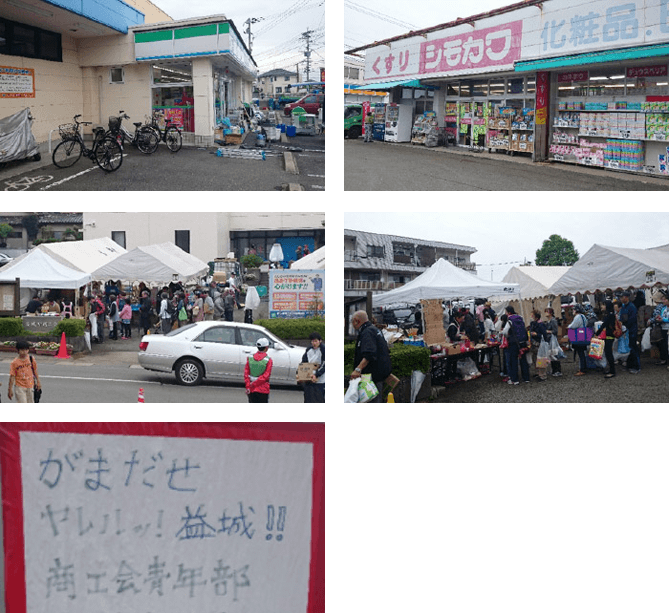
However, the Mashiki-machi Town Office was closed because it was partially destroyed by the main shock. The plate marking the name of the office in front of the Town Office was peeled off, and some statues had also collapsed. Since the Town Hall could not be used, the “Disaster Countermeasure Headquarters” of Mashiki-machi was set up in the Mashiki-machi Health and Welfare Center. However, because a portion thereof also served as a shelter, the staff members of the headquarters were in a situation where they were forced to handle disaster response works within an extremely narrow space surrounded by evacuees. In addition, the issuance of "Disaster Certificates”, which had already started in Kumamoto City, etc., had not started, and from the lack of manpower of the office staff and the work environment handicap of the Disaster Countermeasure Headquarters, we had the impression that it had not yet left the stage of disaster emergency response. In addition, despite the fact that after the Great East Japan Earthquake the wide-area support system between local governments had been strengthened, and human resources had been gathering here to provide support from other local governments, it seems that they were not being fully utilized. (As taking pictures of the inside of Mashiki-machi Health and Welfare Center was forbidden, the picture posted here is only of the outside.)
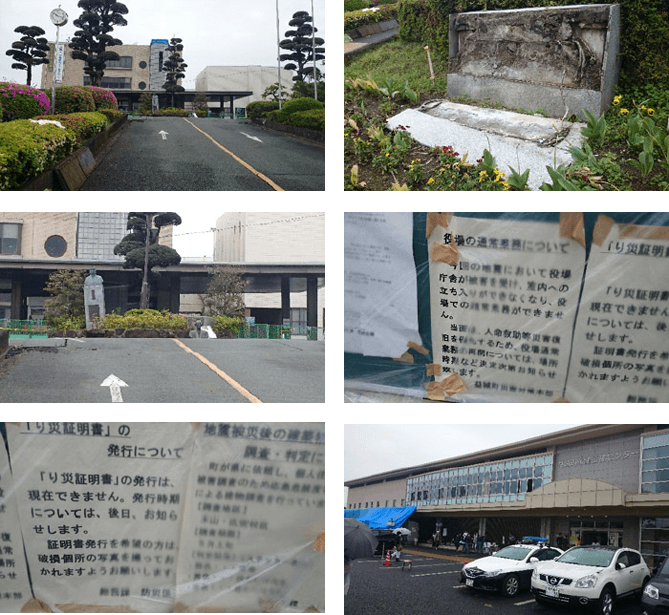
In addition, the damage situation in the area around the Town Hall was especially terrible; there were many homes that had completely collapsed. On the other hand, by moving away from said area by even a little bit, areas where the damage was minor were also seen, highlighting the massive difference which is a feature of earthquake disasters.
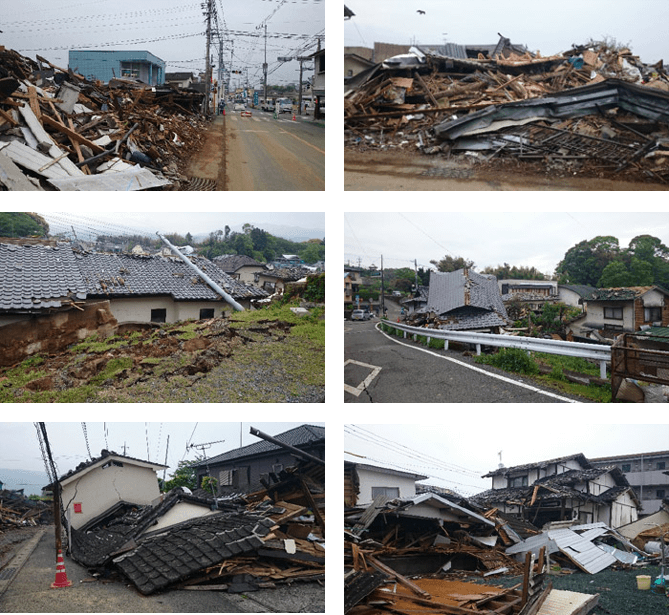
(2)The situation in Kumamoto City
We moved from Mashiki-machi to Kumamoto City. Here, compared with Mashiki-machi, the speed of restoration seemed to be fast and tranquility seemed to have returned. In the shopping areas in the center of Kumamoto City, even though there were shops that had their shutters closed and there were stores still undergoing repair work, there were hints of the crowds returning. There were also some restaurants that were calling out to customers due to the decrease in business travelers and tourists.

(3)The situation of Kumamoto City Hall
In Kumamoto City, a government-designated city, they were already accepting applications for "Disaster Certificates”, and briefing sessions for free provision of municipal housing were also being held because there were plenty of personnel. Also, empty spaces were being used as emergency shelters. Even though sufficient time after the disaster had already elapsed, the staff of the department in charge of receiving applications for "Disaster Certificates” and municipal housings were extremely busy, while the other department officials appeared to work in a more relaxed manner. We had the impression that proper staff assignment at the time of disaster emergency response was not sufficient. Regarding these points, it seems that verification is necessary in the future.
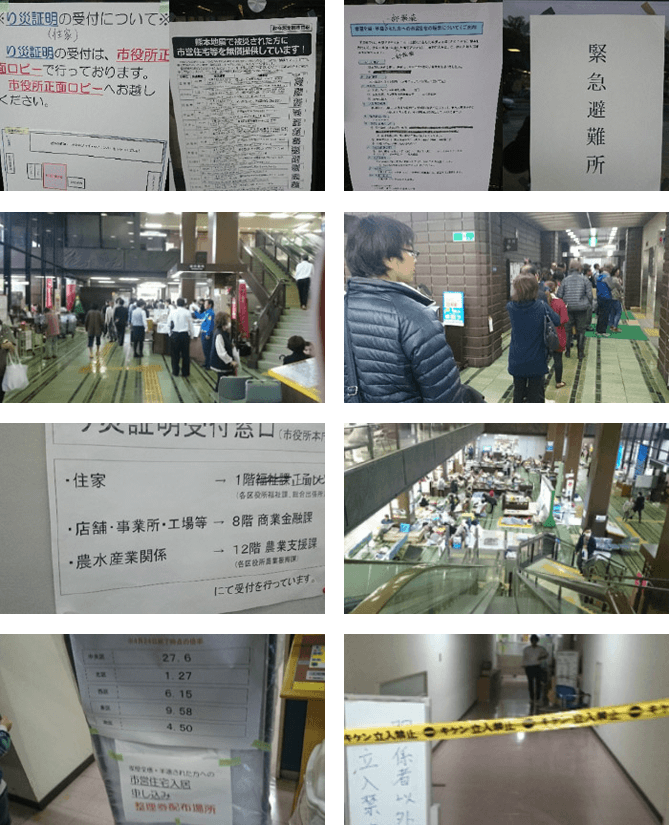
(4)The situation of Kumamoto Castle
The Ishigaki (stonewall) of Kumamoto Castle, located across the street from Kumamoto City Hall, was partly collapsed as reported in mass media.

(5) Kumamoto Prefectural Government / National Emergency Disaster Countermeasure Local Headquarters
Maybe because it was nearly two weeks since the disaster occurred, it was relatively calm in the Prefectural Government. In the Prefectural Government building, the National Emergency Disaster Countermeasure Local Headquarters was established, around which members of the media gathered. We only took pictures of the outside of the Prefectural Government building this time and left it without taking pictures of the inside. This time, it appears that the National Emergency Disaster Countermeasure Local Headquarters was established quickly. At 9:31 pm, just five minutes after the fore shock occurrence on the 14th, the Countermeasure Office was set up in the Office of Prime Minister and the Emergency Response Team was convened. Then at 9:36 pm, the Prime Minister's orders were issued. In addition, at 10:10 pm, the National Emergency Disaster Countermeasure Headquarters was set up in the Cabinet Office, led by director-general Kono, Minister of State for Disaster Management; at 11:25 pm, the Cabinet Office Information Advancement Team departed for the disaster area; the next day, the 15th, at 10:40 am, Matsumoto, Deputy Minister of State for Disaster Management, was appointed as the head of the National Emergency Disaster Countermeasure Local Headquarters established in the Kumamoto Prefectural Government building. Since it was immediately after the revision of the "National Emergency Disaster Countermeasure Local Headquarters Operation Manual" dated March 25, 2015, operational function was greatly enhanced. Future consideration is needed to confirm as to whether the operational aspects worked as expected.
Also, a particularly characteristic feature of the Kumamoto Earthquake is that the wide-area support system in administrative fields other than firefighting and the police was enhanced. At the time of the Great East Japan Earthquake, except for a few exceptions, there was no system for the government to adjust/manage the support provided to local public bodies. Therefore, the Ministry of Internal Affairs and Communications, the Association of Prefectural Governors, the National Association of Mayors, and the National Association of Towns and Villages had to cooperatively establish a tentative scheme to execute wide-area support among local public bodies. Based on the lessons learned, the adjustment regulations between prefectures concerning support of local public bodies related to disaster emergency measure work were improved and new national adjustment regulations were also established. Regarding fire-fighting, flood prevention, and life-saving, it was conventionally limited to tasks targeted for support in emergency measures of extremely high urgency, but after that, the target was expanded to disaster emergency response in general, including evacuation center management, periodic health consultations, facility repairs, etc.
This time, we saw many general staff and vehicles of other local public bodies, which seem to have carried out wide area support along with the institutional change in the disaster area. Inside the Kumamoto Prefectural Government building, the local measures headquarters was set up to oversee overall communication adjustment between prefectures and municipalities that have gathered from across the country.
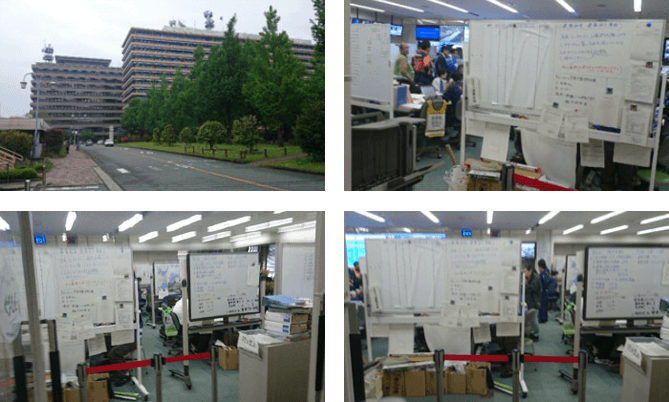
National Government's Responses in Three Days After The Disaster
| April 14 | 21:26 | Earthquake occurrence |
| 21:31 | Countermeasure Office in the Office of Prime Minister, Convocation of Emergency Response Team | |
| 21:36 | Issuance of Orders from the Prime Minister | |
| 21:55 | Emergency Response Team Consultation | |
| 22:10 | Establishment of National Emergency Disaster Countermeasure Headquarters | |
| 23:21 | The 1st National Emergency Disaster Countermeasure Headquarters Meeting | |
| 23:25 | Departure of the Cabinet Office Information Advancement Team | |
| April 15 | 5:59 | Emergency Response Team Consultation |
| 8:08 | The 2nd National Emergency Disaster Countermeasure Headquarters Meeting | |
| 10:40 | Establishment of National Emergency Disaster Countermeasure Local Headquarters | |
| 13:00 | Joint Session between National Emergency Disaster Countermeasure Local Headquarters / Kumamoto Prefecture Emergency Disaster Countermeasure Headquarters | |
| 16:07 | The 3rd National Emergency Disaster Countermeasure Headquarters Meeting | |
| 17:00 | Joint Session between National Emergency Disaster Countermeasure Local Headquarters / Kumamoto Prefecture Emergency Disaster Countermeasure Headquarters | |
| April 16 | 1:25 | Earthquake occurrence |
| 2:38 | Issuance of Orders from the Prime Minister | |
| 2:38 | Emergency Response Team Consultation | |
| 5:10 | The 4th National Emergency Disaster Countermeasure Headquarters Meeting | |
| 10:00 | Joint Session between National Emergency Disaster Countermeasure Local Headquarters / Kumamoto Prefecture Emergency Disaster Countermeasure Headquarters | |
| 11:30 | The 5th National Emergency Disaster Countermeasure Headquarters Meeting | |
| 16:00 | Joint Session between National Emergency Disaster Countermeasure Local Headquarters / Kumamoto Prefecture Emergency Disaster Countermeasure Headquarters | |
| 18:34 | The 6th National Emergency Disaster Countermeasure Headquarters Meeting |
Remarks: Prepared using "About The Damage Situation, Etc., Related to the Earthquake with the Seismic Origin Coming from the Kumamoto District (2016)" of the Cabinet Office.
(6)Uto City Hall
We also visited the Uto City Hall, which was greatly damaged by the earthquake disaster. However, except for the City Hall, the damage to the surrounding buildings seemed to be minimal as far as they were seen from the outside.
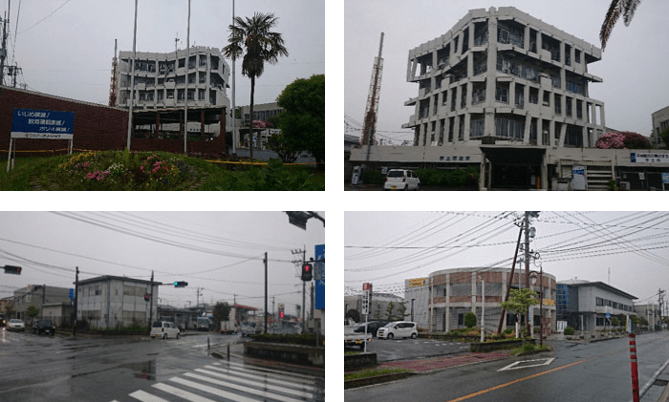
Summary
Although it still needs to be verified, the part that was strengthened after the Great East Japan Earthquake (vertical management of the national government and wide area mutual support among local governments) appeared to work relatively well in the Kumamoto Earthquake, as expected. On the other hand, problems were found in the disaster response systems between municipalities (regional public assistance) in the disaster area. Municipalities that were damaged this time are mostly small cities, towns, and villages, including Mashiki-machi. In these small municipalities, delays in response due to shortage of resources on a daily basis, such as delays in the issuance of "Disaster Certificates” when compared with larger cities such as Kumamoto City, were observed. Even though the country's vertical management system and the wide area support system between municipalities have been enriched and strengthened, it seems that in the Kumamoto Earthquake, differences in response systems/structures arose, resulting in resource shortages in some municipalities receiving support. Since the Great Hanshin Earthquake, strengthening of the structure for vertical management and horizontal cooperation (wide area support) had been carried out based on the problem of how to supplement regional aid in disaster areas. However, it seems that it is still up to the local municipalities (especially in small cities, towns and villages) to consider how to secure regional public assistance for themselves. How to strengthen regional public assistance and how to construct a more effective wide area support system are only some of the tasks for the future. We would like to continue further research.
Contact:
Faculty of Societal Safety Sciences, Kansai University
569-1098 7-1 Hakubaicho, Takatsuki City, Osaka Prefecture
TEL: (+ 81) 72-684-4000 (main number) FAX: (+81) 72-684-4188